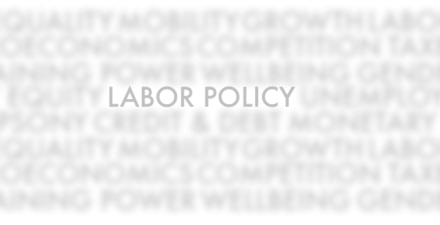Evidence from a new national survey and implications for U.S. federal policy
Executive summary

U.S. employers are deploying artificial-intelligence-powered and automated tools to monitor and manage workers, including tracking workers’ locations, activities, and productivity, and making decisions based on that data about workers’ schedules, tasks, compensation, promotions, and discipline. Researchers, workers’ rights leaders, journalists, and policymakers have raised concerns about how these technologies might negatively affect workers’ health and safety, as well as workers’ access to employment and labor rights.
One significant obstacle to protecting workers has been the lack of data on how common these technologies are in the workforce, as well as their systematic association with worker well-being. To answer these questions, I fielded a new, nationally representative survey of the U.S. workforce intended to provide higher-quality estimates of the prevalence of automated management and surveillance technologies—as reported by workers—and associations with worker well-being.
Surveying nearly 1,300 U.S. workers, I reach three key conclusions, which this report will further examine:
- Workers’ reports of automated surveillance and monitoring are widespread across the U.S. workforce, cutting across earnings, educational, industry, and occupational lines and affecting more than two-thirds of workers, although the specific forms of surveillance vary within these categories. Automated management of workers’ tasks and schedules is less commonly reported by workers but still affects a substantial proportion of workers—around a third of all working adults in the United States.
- These technologies, especially electronic productivity monitoring and automated task-and-schedule management systems, are strongly related to negative health and safety outcomes for U.S. workers. Workers who report more intensive electronic productivity monitoring also report higher levels of anxiety, pressure to work faster than they feel is healthy or safe, and higher incidences of workplace-related injuries in the past year, especially more serious injuries requiring medical attention, time off from work, and changes in job activities. These differences persist even after adjusting for the characteristics of different workers and their workplaces, which ought to be concerning for business executives and workers’ rights leaders, all of whom should carefully assess current workplace practices to ensure that technologies are not harming workers’ health and well-being. This finding also calls for much greater policy attention across levels of government.
- The design and deployment of workplace technologies matter for workers’ health, safety, and well-being. Monitoring used to support workers—for instance, to protect their health and safety or improve their performance—does not appear to be related to negative worker health and well-being outcomes. By comparison, monitoring used to discipline workers or discourage worker voice is much more strongly related to negative worker health and well-being outcomes. This finding underscores the importance of designing and deploying technologies with worker representation and input. Moreover, the finding that some forms of automated surveillance are more prevalentamong unionized workers suggests that worker voice need not be in conflict with well-designed uses of these technologies.
Building on the results of my analysis, I offer policy recommendations for the federal government, focusing on both administrative actions that federal agencies and the White House could undertake now, as well as new legislation that the U.S. Congress might consider.
Introduction

Forecasts about the potential impact of artificial intelligence displacing skills and jobs across the U.S. workforce are dominating national conversations about the “future of work.” Yet equally important are the ways that businesses have already deployed technologies in the workplace that affect the quality of jobs, workers’ well-being, and their access to labor and employment rights.1
In particular, researchers, journalists, advocates, and policymakers have raised concerns about the use of automated technologies to monitor and manage workers on and off the job.2 These technologies—which, in this report, I call automated management and surveillance systems and are sometimes also referred to as electronic surveillance and algorithmic management—involve electronic or automated means of collecting data on workers to inform automated or semi-automated decision-making by employers or other businesses contracting with workers.
While businesses have long used both manual and electronic means of monitoring their workers, electronic systems now expand the scope of monitoring, permitting businesses to monitor more workers more of the time, and to collect more data, as well as use that data to inform decision-making about workers’ tasks, pay, scheduling, and other terms of their working conditions.3
To be sure, these technologies can be beneficial for workers and businesses alike—especially when they are designed and deployed in concert with workers, understanding workers’ needs and perspectives.4 GPS tracking devices paired with panic buttons, for example, can help keep hotel housekeeping staff safe when facing possible harassment or assault. AI-powered cameras also can help proactively identify potential health and safety risks involved in operating heavy machinery and alert workers before they hurt themselves. And sensors on health care workers’ ID badges can help remind those workers to wash their hands in between patients.
Yet automated surveillance and management technologies also pose risks to workers’ physical and mental health and undermine workers’ rights under civil rights, labor, and employment laws. Recent reporting and labor investigations by federal and state agencies have documented how automated productivity tracking—such as electronic quotas that workers are required or encouraged to meet—implemented without worker input or voice can cause workers to speed up and thus make workers more likely to injure themselves.5 Such tracking may also cause more anxiety and stress among monitored workers.
Beyond productivity tracking, automated decision-making systems can embed bias against particular groups of workers, discriminating against women, workers with disabilities, workers of color, and others. And automated monitoring of workers—including their locations, computer or phone usage, and productivity—can be used by employers to discipline workers who try to exercise their rights to organize and form unions.6
Existing evidence suggests that the application of these technologies may be increasing and is common in the private sector, especially as remote work became more widespread throughout the COVID-19 pandemic, and that it can pose important risks to workers’ health, safety, well-being, and access to employment and labor rights. Consider the following recent studies and reporting:
- In 2022, The New York Times found that 8 in 10 of the largest private-sector businesses use some form of productivity tracking on their employees.7 That same piece reported concerns from monitored workers about arbitrary discipline and dismissal, pressure to work faster than would be safe or helpful for patients, customers, and clients, and errors made by automated systems.
- The private-sector consultancy firm Gartner found that the number of large businesses using electronic monitoring tools for their workers doubled since the beginning of the COVID-19 pandemic to some 60 percent.8
- A 2022 survey of human resources leaders by PricewaterhouseCoopers found that 37 percent of leaders had already implemented electronic monitoring of remote workers’ productivity, and another 35 percent were considering or developing a plan to do so.9
- A 2022 survey conducted by International Data Corporation found that nearly 70 percent of North American employers with at least 500 employees report using employee monitoring tools.10
- A report by Coworker.org found hundreds of new technologies marketed to businesses to automatically monitor and manage workers, especially low-paid workers, and developers of those technologies were attracting significant private capital investment.11
- An investigation of Amazon.com Inc. warehouses by The Washington Post found that Amazon’s injury rates among warehouse workers were substantially higher, compared to other warehousing companies, and that some of this difference may be attributable to the electronic productivity monitoring that Amazon deploys in its warehouses. This conclusion was further buttressed by a study surveying nearly 1,500 front-line Amazon warehouse workers across more than 400 facilities, which found that those workers report high rates of injury, a sense that they needed to work faster than was healthy or safe, and more workplace monitoring at Amazon than in other jobs.12 An initial investigation by a labor enforcement agency in Washington state found that Amazon’s practices, including the use of productivity tracking, forced warehouse and delivery workers to work at unsafe speeds, though a judge later cleared Amazon of those citations.13
- Surveys of union organizers have found that the percentage of elections organized by the National Labor Relations Board where employers deployed electronic surveillance of workers more than doubled between 1999–2003 and 2016–2021, rising from 14 percent to 32 percent of all elections.14
- A survey of call center workers in the United States and Canada in 2022–2023 found that greater intensity of automated management tools was associated with lower employee well-being, job satisfaction, and emotional health.15
- Exploratory surveys of workers employed in warehousing, telecommunications, retail, hospitality, and health care found that substantial proportions of workers—some 40 percent to 50 percent—report electronic productivity monitoring at work.16
Most of what we know to date comes from investigative reporting, case studies of individual employers, qualitative research, private-sector research without transparent methods, or exploratory surveys.17 We therefore lack a more comprehensive picture that would be necessary for policymakers to craft appropriate responses to these technologies and for the public to better understand their use and impacts.
For instance, extensive reporting, labor agency investigations, and case studies of Amazon warehouse workers have found a connection between electronic monitoring of those workers, pressure to work faster than is healthy or safe, and worker injuries.18 But do workers who are exposed to more intensive electronic productivity monitoring outside of Amazon warehouses in other occupations and industries face similar pressures to work faster or experience higher rates of workplace injury? Just how common are other forms of electronic monitoring of workers beyond productivity tracking? And does the form and purpose of monitoring matter for workers’ outcomes—especially the extent to which monitoring is responsive to workers’ perspectives and needs?
To answer these questions, this report details a new nationally representative survey of the U.S. workforce intended to provide higher-quality estimates of the prevalence of automated management and surveillance technologies. The survey uses data from 1,273 respondents surveyed by YouGov in July 2024 using an instrument that I designed.19 Importantly, the National Survey of Workplace Technology focuses on the experiences and perspectives of workers, not businesses, including workers’ perceptions of the use of automated monitoring and surveillance technologies in their workplaces.
This focus on workers carries both strengths and limits. If we are interested in how the use of these technologies shapes workers’ behaviors and outcomes—such as their perceptions of needing to work faster than would be healthy or safe—then it makes sense to focus on workers’ own perceptions and experiences. At the same time, given that automated management and monitoring technologies can operate without workers’ knowledge—and given that, in most contexts, employers are not necessarily required to disclose their use to workers—workers may not be aware of the full extent to which they are exposed to automated management and surveillance systems. In other cases, workers may misperceive the use of such technologies, assuming they are in place when they are not.
As such, we should interpret these results as workers’ perceptions. Future studies should focus on the experiences and practices of managers, and how those practices align (or do not align) with workers’ own perceptions.
The National Survey of Workplace Technology probed workers’ perceptions of the extent to which the organizations with which they work—employers in the case of employees and clients or mediating businesses in the case of independent contractors and consultants—used a variety of electronic surveillance tools (including cameras, productivity tracking, and location tracking), as well as automated methods of task or schedule assignments.20 In addition, the survey asked workers who reported experiences with at least some form of electronic monitoring how they perceived that monitoring was being used—for instance, for health and safety purposes, to improve their work products, or for discipline.
The survey also focused on the health, safety, and mental well-being of workers to better understand the relationship with the frequency of automated management and monitoring. I focus on health, safety, and well-being, given the substantive importance of these outcomes, as well as the past work, cited above, that suggests a link between exposure to automated management or monitoring and negative health, safety, and well-being outcomes for workers. There are a number of other outcomes that merit study—for instance, the impact of these technologies on discrimination or workers’ access to collective action—and further research should focus on these potential effects.
Results from the National Survey of Workplace Technology

Results from the survey yield several insights into the use of automated management technology and worker surveillance systems in the U.S. workforce. Below, I examine each insight in turn.
Most U.S. workers report some form of electronic monitoring on the job
Most commonly, workers report that their use of work-related smartphones, tablets, or computers were monitored.21 Monitoring involving cameras, productivity tracking, or location tracking were less common, but still reported by 27 percent to 45 percent of workers, depending on type of monitoring. In all, more than two-thirds (68 percent) of U.S. workers report at least one form of electronic monitoring. (See Table 1.)
Table 1

Many U.S. workers report automated task or schedule assignments
Around 4 in 10 U.S. workers report that either their schedules or work tasks are assigned by automated systems.22Thirty-four percent of workers report that their schedules are assigned automatically all the time or some of the time (including 16 percent reporting all the time), and 32 percent report that their tasks are assigned automatically all the time or some of the time (including 15 percent reporting all the time). (See Table 2.)
Table 2

Workers also tended to report that these decision-making systems went hand in hand: Most workers who report that their schedules are assigned automatically also report that their tasks are assigned automatically.
U.S. workers of all backgrounds and income levels experience automated management and surveillance, though non-White workers report more
Reports of automated management and surveillance technologies were similar across educational and earnings lines. Workers with lower and higher levels of formal educational attainment were similarly likely to report the use of automated management and surveillance systems. (See Figure 1.)
Figure 1

Likewise, regardless of weekly wages, workers all along the earnings distribution report experiencing automated surveillance in the workplace at similar levels. (See Figure 2.)
Figure 2
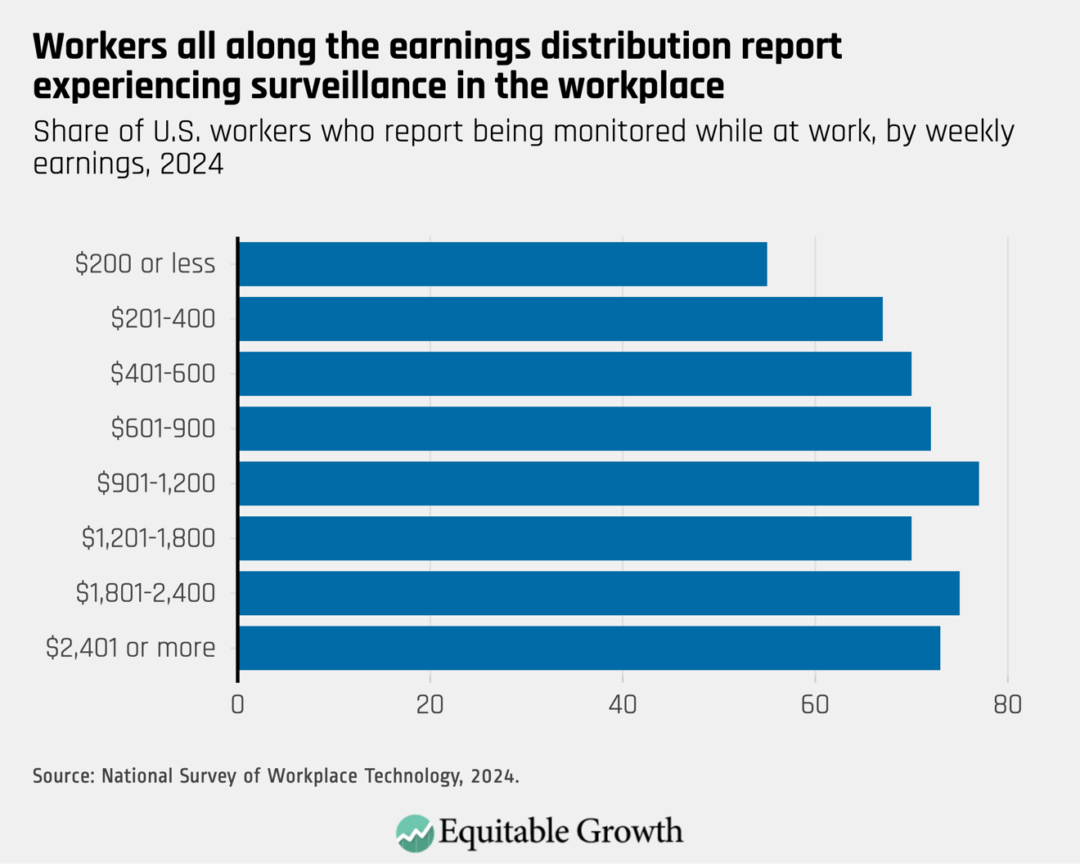
At the same time, there were large differences by race. Black, Hispanic, and other non-White workers were substantially more likely to report that they either experienced electronic monitoring or had their schedules and tasks assigned automatically by computer systems.
Thirty percent of White workers report that their schedules were set automatically all of the time or some of the time, compared to 52 percent of Black workers and 46 percent of Hispanic workers. Similarly, 65 percent of White workers report at least some form of electronic monitoring at work, compared to 82 percent of Black workers and 73 percent of Hispanic workers. (See Figures 3 and 4.)
Figure 3
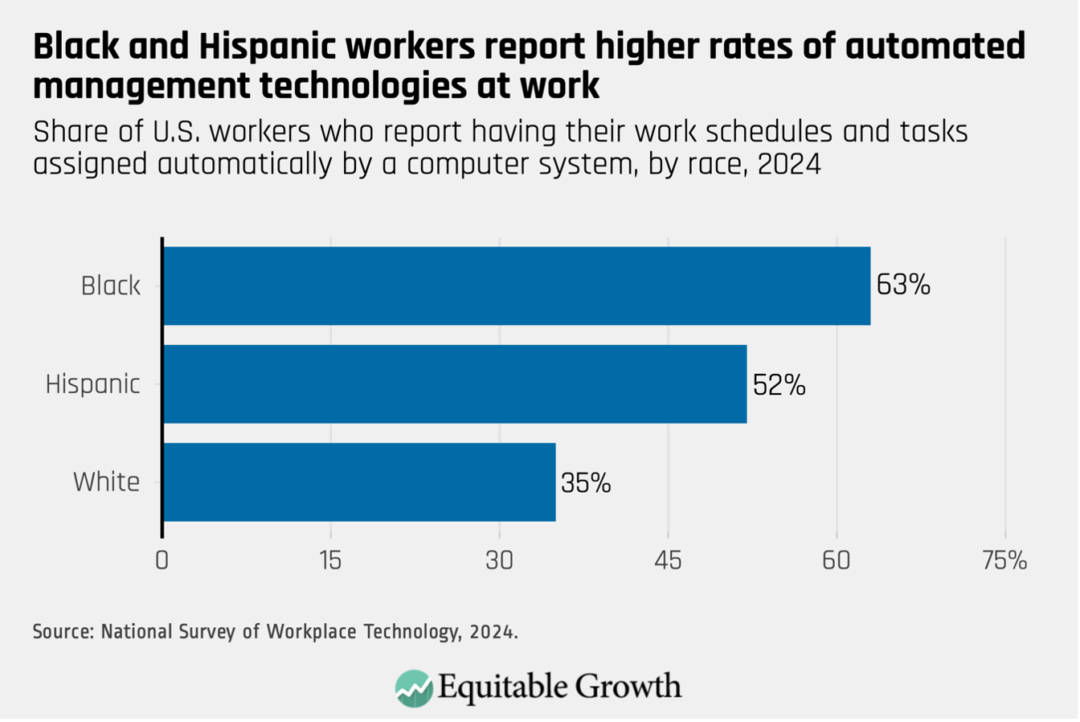
Figure 4
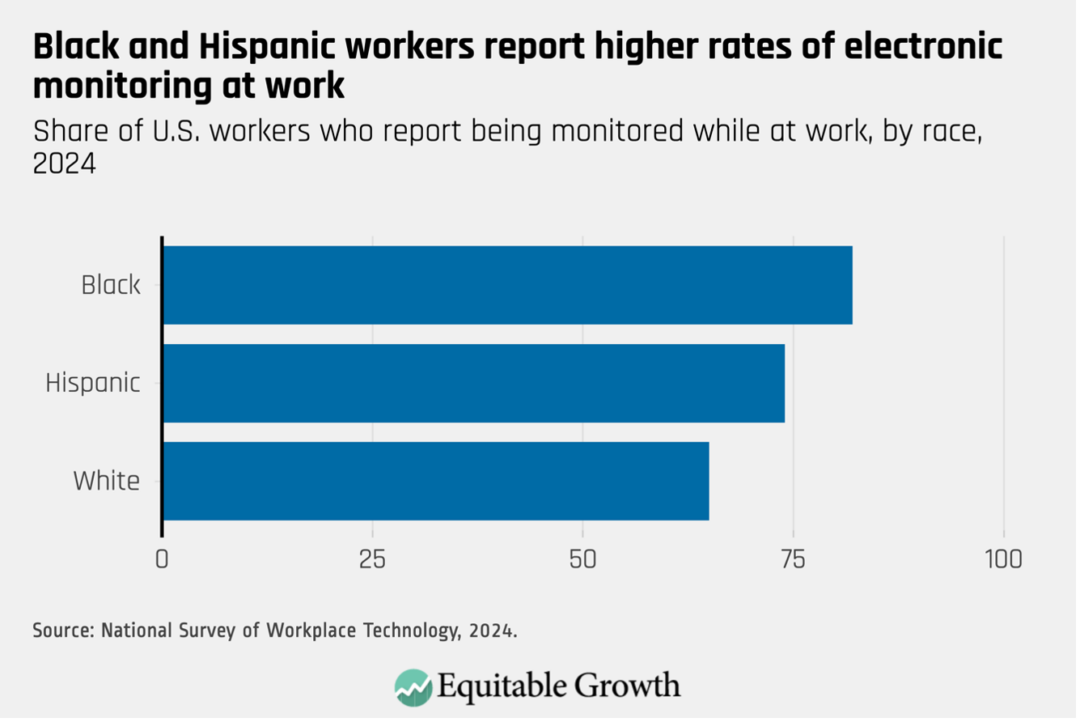
These differences by race reflect the distribution of workers across occupations and industries: Black and Hispanic workers tend to work in occupations and industries with more intensive monitoring.
Workers in certain U.S. sectors and jobs see more monitoring and surveillance
Reports of automated management and surveillance were especially high in transportation and health care support jobs. Table 3 indicates the industries where any form of electronic monitoring was more or less prevalent compared to the national average of 68 percent. (See Table 3.)
Table 3

Reports of surveillance and monitoring were also higher in larger organizations.Eighty-eight percent of U.S. workers who work for organizations with 1,000 or more workers report some form of monitoring, compared to 43 percent of workers in smaller organizations with fewer than 10 workers. Automated scheduling was similarly more common in larger organizations compared to smaller ones.(See Figure 5.)
Figure 5
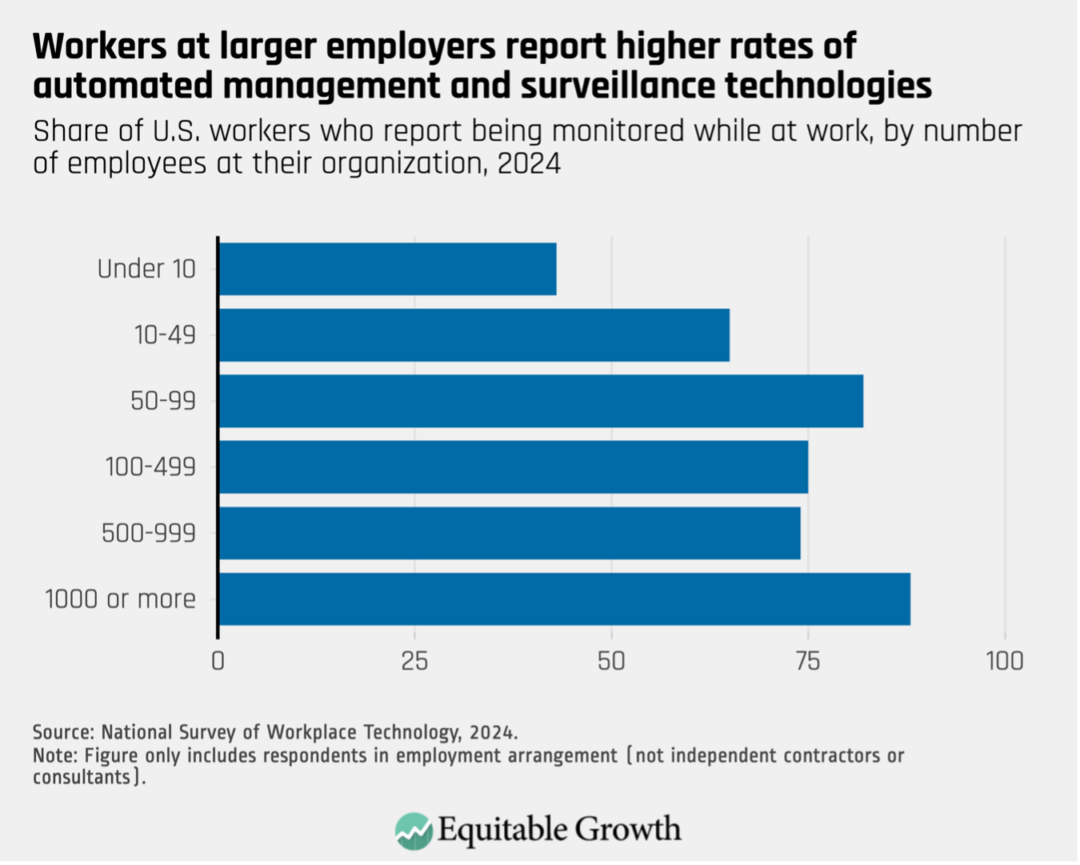
U.S. workers vary in their perceptions of why their organizations use technology
Workers were divided in their understanding of how their organizations use automated management and surveillance technologies.Forty-two percent of workers agreed that the technologies were used to protect worker health and safety.23 A slightly lower percentage—38 percent—thought that it was used to recognize quality work, while 36 percent thought it was to help workers improve their performances. Lower percentages thought that organizations used these technologies to discipline workers (31 percent) or discourage workers from discussing workplace issues and problems (18 percent).
Surveillance and monitoring in unionized workplaces
Unionized workers were more likely to report the use of automated management and surveillance technologies, but also more likely to report that they recognized how employers were using their technologies, especially for health and safety purposes.Eighty-five percent of unionized workers report that they were monitored, compared to 64 percent of nonunionized workers.
Yet unionized workers were more confident in reporting how their employers used these technologies and were especially likely to report that they were used for protecting worker health and safety (65 percent, compared to 37 percent for nonunionized workers). That makes sense, given that unions have long used collective bargaining to set standards on how technologies would be used in the workplace, especially for health and safety purposes.24
Technology and worker safety and well-being
Workers who reported higher usage of electronic productivity monitoring and automated management technologies also were more likely to report working faster than would be healthy or safe, more likely to report being anxious at work, and more likely to report having experienced a workplace-related injury in the past year, especially a more serious injury.
Workers who reported more frequent productive monitoring also were substantially more likely to agree that they worked “faster than is healthy or safe.”25 Forty-six percent of workers who said that their productivity was monitored “all the time” agreed they worked too fast, compared to just 15 percent of workers who said that their productivity was never monitored electronically. (See Figure 6.)
Figure 6
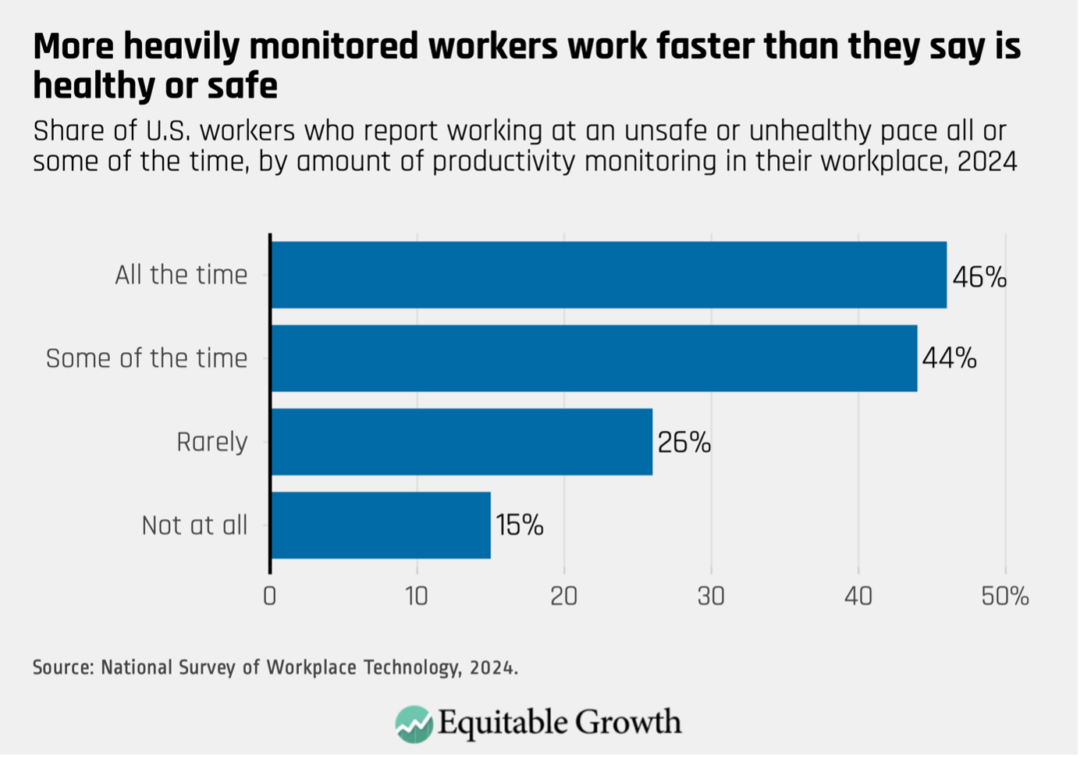
Additionally, workers who reported higher usage of electronic productivity monitoring also were more likely to say that they felt anxious at work. Fifty-three percent of workers who said that their productivity was monitored “all the time” agreed that they felt anxious at work all or some of the time, compared to 41 percent of workers who said that their productivity was never monitored electronically.26 (See Figure 7.)
Figure 7
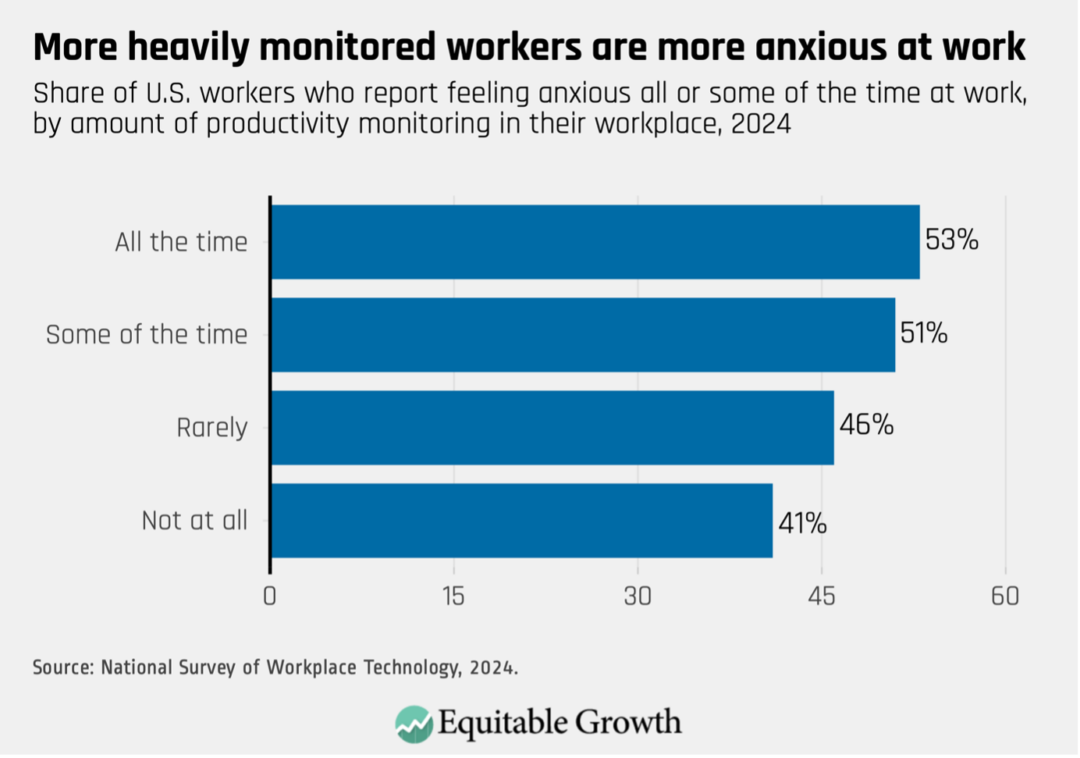
Most disconcerting, workers who reported more intensive electronic productivity monitoring also were more likely to say that they had been injured on the job in the past year, though the baseline level of workplace injuries was relatively low overall, with just 7 percent of workers overall reporting workplace injuries in the past year.27 About 9 percent of workers who said that their productivity was monitored “all the time” reported a workplace-related injury in the past year, compared to about 4 percent of workers who said that their productivity was never monitored electronically. (See Figure 8.)
Figure 8
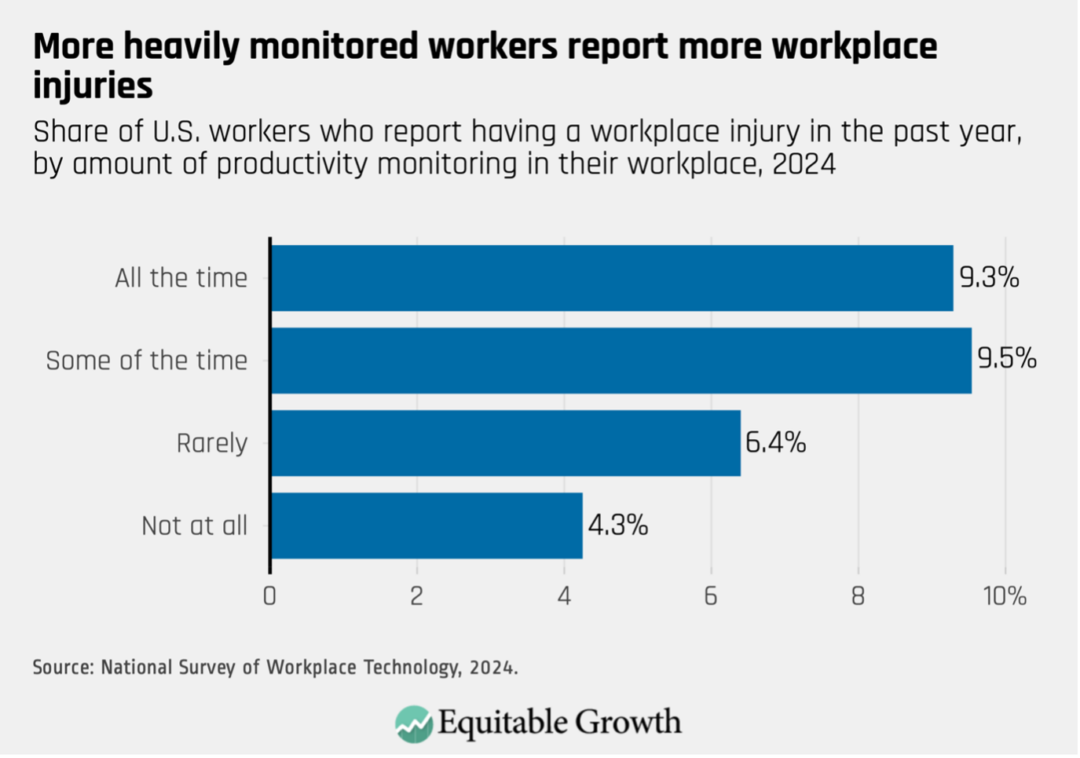
Injuries reported by workers who experience more intensive electronic productivity monitoring were more likely to be serious, compared to workers reporting less intensive monitoring. I probed whether workers who reported workplace-related injuries required first aid or medical treatment, time off from work, or a change in job activities.28 Among workers reporting electronic monitoring “all the time,” 7 percent reported having injuries requiring medical attention, compared to just 2 percent for workers reporting no monitoring. Five percent of workers reporting electronic monitoring “all the time” said that they had injuries requiring time off, compared to less than 1 percent of workers reporting no monitoring. And 3 percent of workers reporting electronic monitoring “all the time” reported injuries requiring changes in job activities, compared to less than 1 percent of workers reporting no monitoring.
I observed similar patterns when looking at automated management of tasks and schedules. Forty-seven percent of workers who reported that their tasks were assigned automatically “all the time” agreed that they worked too fast for their health and safety, compared to just 15 percent of workers who said that they were never assigned tasks automatically. (See Figure 9.)
Figure 9

Automatic task management was strongly related to workplace injuries, too. Ten percent of workers reporting tasks were assigned automatically “all the time” reported a workplace-related injury, compared to just 5 percent of workers who were never assigned tasks automatically. (See Figure 10.)
Figure 10
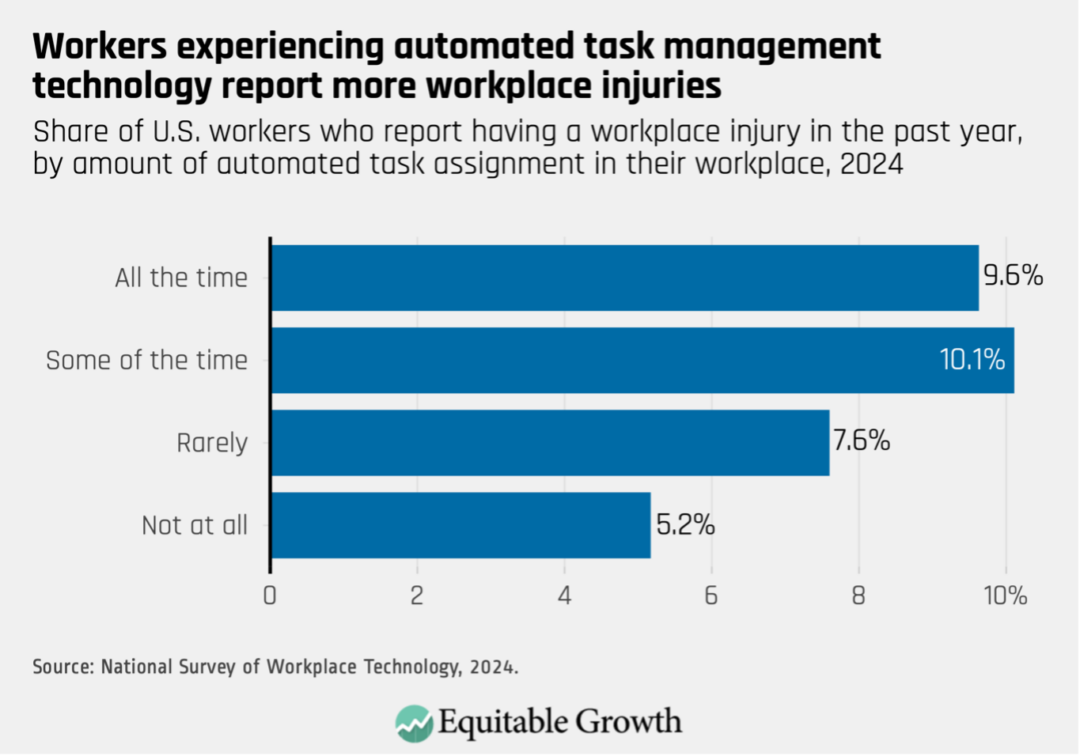
One important question is whether these relationships are causal or simply reflect other characteristics of workers, work arrangements, and employers. While this survey cannot answer this question definitively, I did probe whether the relationships hold up after adjusting for respondents’ work and demographic characteristics.29 I find this to be the case, providing suggestive evidence that these relationships do not simply reflect underlying characteristics of individual occupations or industries, or the distribution of such technologies across differently sized organizations or unionized versus nonunion organizations.
Figure 11 shows that the differences in workers reporting that they must work faster than is healthy or safe remain across levels of electronic productivity monitoring even after adjusting for a range of worker and workplace characteristics. (See Figure 11.)
Figure 11

Similarly, I find that the differences in workplace injuries remain after adjusting for those worker and workplace characteristics. Workers reporting electronic productivity monitoring all the time were nearly twice as likely to report a workplace injury in the past year, compared to workers reporting that their productivity is never electronically monitored (9.6 percent versus 5.2 percent), adjusting for other individual and workplace characteristics.
Monitoring for disciplinary or punitive reasons has negative health effects on workers
Workers who reported that electronic monitoring was used to discipline workers or suppress worker voice saw the largest negative health and well-being effects of monitoring.Looking at all workers who reported workplace monitoring, I find no relationship between electronic monitoring used to promote workers’ health and safety or improve workers’ performance and worker reports of needing to work too fast and workplace injuries. By comparison, I find a much stronger relationship between the use of monitoring to either discipline workers or suppress workers from raising issues or problems on the job and workplace issues and injuries.
Sixty-seven percent of workers who strongly agreed that their organizations used electronic monitoring to suppress workers from raising issues or problems said that they needed to work faster than would be healthy or safe, compared to just 14 percent of workers who strongly disagreed that their organizations used monitoring to suppress worker discussions and worker voice. In a similar vein, 57 percent of workers who strongly agreed that their organizations used monitoring to discipline workers said that they worked too fast, compared to 14 percent of workers who strongly disagreed that their organizations used monitoring in this way. (See Figure 12.)
Figure 12
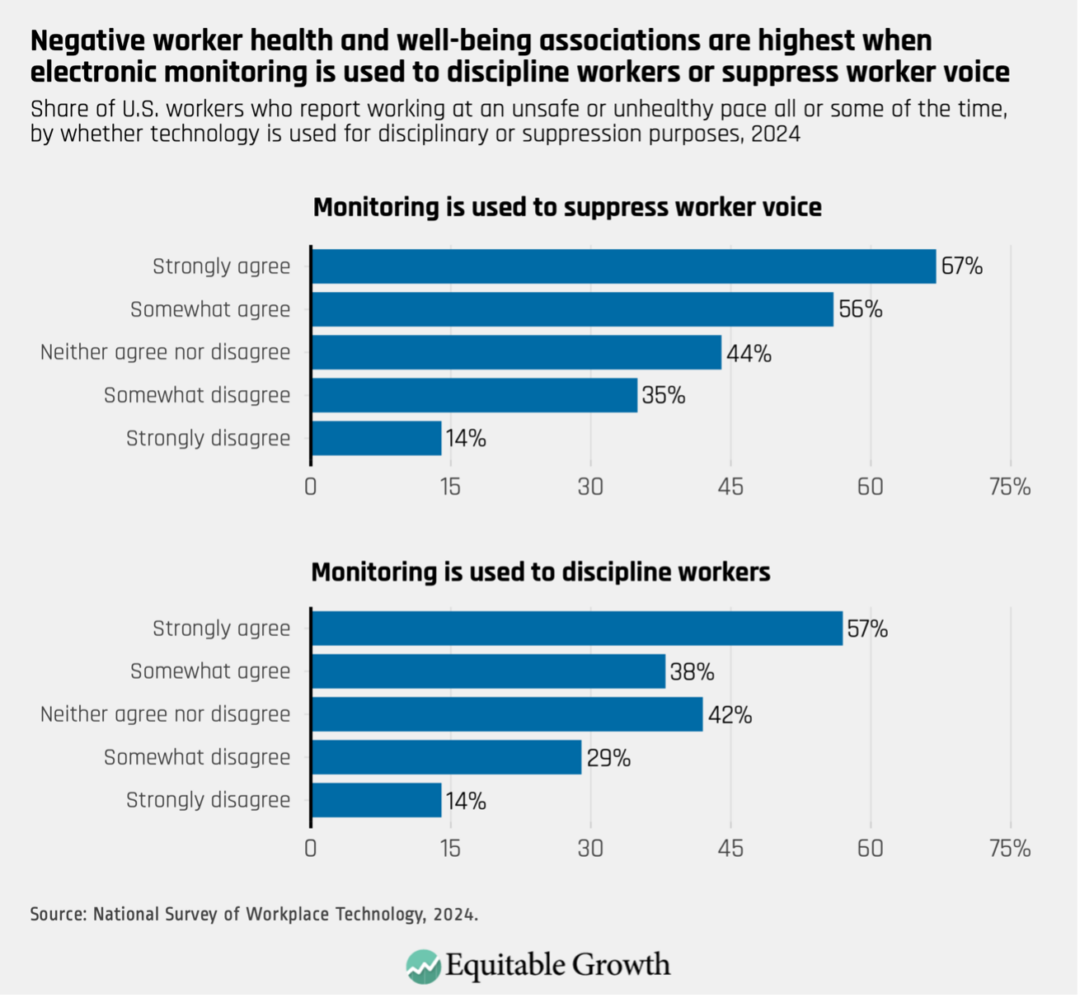
These comparisons also persist when controlling for the same worker and workplace characteristics described above.
Implications for federal policymakers

Together, these findings suggest that the purpose, design, and deployment of monitoring technologies matter—not all monitoring technologies are equal or have equivalent effects on workers. From workers’ perspectives, technologies used to promote health and safety and improve their performances may not have the same deleterious effects as monitoring used to suppress worker voice or discipline workers. This finding underscores the need to incorporate workers’ perspectives into the design and deployment of automated management and surveillance systems, ensuring that monitoring is responsive to, and respectful of, workers’ needs.
At the federal level in particular, the survey results call for further research from public and occupational health authorities, as well as heightened enforcement activity. Below, I spell out immediate steps that the executive branch might consider through existing federal authorities, as well as legislative actions that Congress might consider.
Administrative actions to support more research and data collection on automated management and surveillance technologies
The White House
The White House, in conjunction with the U.S. Department of Labor, should convene employers, technology developers, and worker organizations to better understood how and why employers are deploying automated management and surveillance technologies; how developers are designing these technologies; what the impacts are on workers and businesses; and how to better design technologies in ways that are beneficial for workers and employers alike.
Occupational Safety and Health Administration and National Institute for Occupational Safety and Health
The Occupational Safety and Health Administration should work with the Centers for Disease Control and Prevention’s National Institute for Occupational Safety and Health to further study the impacts of automated management and surveillance technologies on workers’ physical and mental health. NIOSH researchers have recently underscored the importance of psychosocial hazards for workers’ health, risk of injuries or disabilities, and costs, including needing to work too fast.30 These priorities fit well within the Surgeon General’s new framework on mental health, which focuses on the workplace as one important driver of mental well-being or harm.31
Further studies by the National Institute for Occupational Safety and Health could more definitively establish causal relationships between the use of these technologies and worker outcomes, as well as the specific designs and forms of automated monitoring or management most likely to cause negative health and well-being effects.32 In particular, the institute and the Occupational Safety and Health Administration both should consider how worker representation in the design and use of automated management and surveillance technologies matters for health, safety, and well-being outcomes.33 OSHA has already flagged the use of automated management in warehousing and transportation and its connection to illness and injuries as being an area in need of further research in the Department of Labor Chief Evaluation Office’s 2022–2026 Evidence-Building Plan.34
Bureau of Labor Statistics and U.S. Census Bureau
The U.S. Department of Labor’s Bureau of Labor Statistics should work with the U.S. Census Bureau to collect data on workers’ reports of exposure to automated management and surveillance technologies, potentially though a new supplement to the Current Population Survey that would also ideally include measures of worker health, safety, and well-being.35
In parallel, the Census Bureau should also collect data from managers and business owners on their deployment of these technologies, potentially through a new supplement to the Annual Business Survey. The Annual Business Survey already includes items related to development and deployment of new technologies.36 These surveys could help gauge the changing deployment of technology across the U.S. workforce and inform enforcement agency activities and targeting.
Federal Acquisition Regulatory Council
The president should direct the Federal Acquisition Regulatory Council, in consultation with the U.S. Department of Labor, to promulgate new regulations on federal contractors. The council should request systematic information on their use of automated management and surveillance technologies under the argument that these technologies can affect the economy, efficiency, and effectiveness of federal procurement—particularly if such technologies increase worker turnover or increase worker compensation costs or reduce working time due to higher injury rates.37
Office of Management and Budget and Office of Personnel Management
The White House Office of Management and Budget, through an M-memo from the director to federal agency heads, should inventory federal regulations, guidance, and funding opportunities to study whether federal agencies are currently requiring or incentivizing the use of automated management and surveillance technologies, building on existing AI reporting requirements and applying to federal agencies’ own workforces, federal contracts, and federal grants. If so, the Office of Management and Budget should determine whether those technologies have been designed in consultation with affected workers and whether they are having (or are likely to have) negative consequences on workers’ health and safety.38
The Office of Management and Budget and the Office of Personnel Management also should collaborate with federal agencies and the unions representing federal workers to make federal jobs models for all employers in terms of the use of automated management and surveillance. Government jobs had a disproportionately high rate of monitoring, as reported by workers in the survey. As such, these agencies should inventory other federal agencies to understand what automated management or monitoring they may use and ensure that those technologies have been designed in consultation with affected workers, including through collective bargaining with federal unions, and potential impacts on worker health and safety. This is especially important if the federal government is concurrently taking steps to regulate automated management and surveillance among federal contractors.
Administrative actions to increase enforcement and counteract the negative impacts of automated management and surveillance technologies
Occupational Safety and Health Administration
The Occupational Safety and Health Administration should begin the process of developing a standard to protect workers against the health and safety effects of automated management and surveillance technologies, building on the research cited and described in this report.39 The development of the standard, and the eventual standard itself, should consider how to ensure maximum feasible worker representation in the design and use of automated management and surveillance technologies. The agency should begin by issuing an advance notice of proposed regulation, as it did with its recent effort to regulate workers’ exposure to extreme heat, to get broad input from workers, businesses, technology regulators, researchers, and state and local governments to inform a proposed standard.40
In parallel, and drawing on public consultations with workers, employers, researchers, technology developers, and other policymakers, the agency should announce a national emphasis program—a temporary program focusing OSHA resources on particularly hazardous industries—for industries known to use automated management and surveillance, building on its recent national emphasis program in warehousing and distribution centers.41 Such targeting could use data from this survey, as well as, ideally, from larger-scale surveys from the Census Bureau and Bureau of Labor Statistics.
At the same time, the agency should develop and issue subregulatory guidance to employers on best practices for the design and development of automated management and surveillance technologies that incorporate worker perspectives and do not threaten workers’ health or safety.42 The agency also should promulgate regulations requiring employers to disclose the use of automated management and surveillance systems in reporting on workplace injuries.
Federal Acquisition Regulatory Council
The president should direct the council, in consultation with the U.S. Department of Labor, to promulgate new regulations on federal contractors, barring the use of automated management and surveillance technologies for workers employed on federal contracts unless the contractor can affirmatively demonstrate that the technologies do not pose a threat to workers’ health and safety. As with the recommendation for the council listed above, this regulation would be issued under the argument that such technologies can affect the economy, efficiency, and effectiveness of federal procurement through increased injuries and job strains among affected workers.
Legislative actions
At a basic level, the U.S. Congress should appropriate additional funds and full-time staff to the U.S. Department of Labor to ensure that the department has sufficient resources and personnel (including appropriate expertise) to address automated management and surveillance research and enforcement needs. This should include funding for the Bureau of Labor Statistics, Occupational Safety and Health Administration, the Office of the Solicitor of Labor, and the Office of the Assistant Secretary for Policy, among others. It could entail, as some recent legislation has done, the creation of a new office within the Department of Labor focused exclusively on the use of workplace technology and its implications for workers’ labor and employment rights.
While OSHA already has the statutory authority to develop standards such as the one described above, Congress could send a strong signal to the executive branch to prioritize this proposal by directing OSHA to develop such a standard in legislation.
Beyond ensuring sufficient capacity for the Department of Labor to carry out its current authorities and signaling prioritization of this issue, Congress should set standards on how businesses can deploy automated management and surveillance technologies. These should include the following principles:43
- Requiring meaningful and ongoing consultation with workers and their chosen representatives in the design and administration of automated management and surveillance technologies
- Requiring disclosure of automated management and surveillance technologies to workers and their chosen representatives, including regularly sharing with workers any data that are collected and how those data are used by businesses in a timely, transparent, and public manner
- Permitting workers to dispute and correct data collected through automated management and surveillance technologies, including through their chosen representatives in such disputes
- Prohibiting the collection of sensitive data and continuous monitoring of workers by businesses
- Restricting the use or resale of data collected by automated management and surveillance technology beyond immediate workplace decisions
- Ensuring that the use of automated management and surveillance technology does not endanger workers’ health and safety
While the potential risks posed by automated management and surveillance technologies are significant, the good news is that policymakers already have a range of levers that they can deploy now to begin addressing those risks. And there is evidence that the public agrees with such an approach.
In the National Survey of Workplace Technology, I asked respondents about their support for a hypothetical piece of legislation that would “regulate employers’ abilities to electronically monitor workers.” I described the legislation in the following way, giving arguments for and against the bill:
“The legislation would require employers to disclose whether they are electronically monitoring their workers and how electronically-collected information is used. The legislation would also give workers the right to correct any electronically-collected information used in employment decisions, like whether to discipline or fire workers. Supporters say the legislation would protect workers’ privacy and prevent employers from using faulty information. Opponents say the legislation would be costly for employers and limit employers’ abilities to manage workers.”
A majority of workers surveyed—53 percent—said that they either strongly or somewhat supported the bill, outnumbering opposition by more than 3-to-1. Just 15 percent of workers said that they opposed the bill. The remaining workers said they were not sure or neither supported nor opposed the bill. Although support was stronger among Democrats, at 62 percent, 48 percent of Republicans still supported the bill, as did 53 percent of Independents.
U.S. workers are supportive of action on automated management and surveillance in their workplaces—and policymakers ought to follow their lead.
Conclusion

Past research and reporting has drawn important attention to the ways that automated monitoring and management tools may be becoming more prevalent across the U.S. workforce, especially with the rapid growth of remote work during the COVID-19 pandemic. Examining specific employers, especially Amazon, past research, reporting, and labor investigations also have drawn attention to the potential health and safety impacts of such technologies, pointing out how they can pressure workers to work faster than would be healthy or safe, and contributing to workers’ stress and anxiety.
Yet in the absence of more comprehensive quantitative research, it was not clear whether these issues are more systematic across the workforce. And there is no full picture of the prevalence of automated management and surveillance technologies overall. The National Survey of Workplace Technology aims to provide a higher-quality, comprehensive picture of these trends.
Several key conclusions emerge from the survey results for policymakers and the public. First, worker reports of automated surveillance and monitoring of workers are widespread across the U.S. economy, cutting across earnings, educational attainment, industry, and occupational lines, and affecting more than two-thirds of workers, although the specific forms of surveillance vary within these categories. Automated management of workers’ tasks and schedules is less commonly reported by workers but still affects a substantial proportion of the workforce—around one-third of all working adults.
One important exception to the shared experience of automated management and monitoring is along racial and ethnic lines. Black and Hispanic workers are much more likely to report any form of monitoring than other workers, given the occupations and industries in which they work. This suggests an important racial disparity that business and worker leaders ought to be attuned to when developing and deploying automated management and surveillance technologies—and for policymakers to explore and address.
Second, these technologies—and especially electronic productivity monitoring and automated task-and-schedule management systems—are strongly related to negative health and safety outcomes for workers. Workers who report more intensive electronic productivity monitoring also report higher levels of anxiety, pressure to work faster than they feel is healthy or safe, and higher incidence of workplace-related injuries in the past year, especially more serious injuries requiring medical attention, time off from work, and changes in job activities.
These differences persist even after adjusting for worker and workplace characteristics. This relationship ought to be concerning for business and worker leaders, who should carefully assess current workplace practices to ensure that technologies are not harming workers’ health and well-being. In addition, this relationship calls for much greater policy attention across levels of government.
Third, the survey results suggest that the design and deployment of workplace technologies matter for worker outcomes. Monitoring used to support workers—for instance, to protect their health and safety or improve their performance—does not appear to be related to negative worker health and well-being outcomes. By comparison, monitoring used to discipline workers or discourage worker voice is much more strongly related to negative worker health and well-being outcomes. This finding underscores the importance of designing and deploying technologies with worker representation.44
Unions—and through them, collective bargaining—provide one important vehicle to achieve the goal of worker voice and representation in the adoption and use of workplace technologies, and the survey suggests that unionized workers are especially likely to report that monitoring is used to protect their own health and safety. Just as importantly, unions also bargain over fundamental questions of work-pacing, meaning that even if employers use monitoring to track their workers, unionized workers are less likely to feel pressured to work faster than would be healthy or safe.
Unions also bargain for rules on how workers can be fired, requiring just cause and progressive steps of discipline in most cases, breaking the link between monitoring and arbitrary employment decisions for most unionized workers. In contrast, most private-sector, nonunion workers lack such protections and can be disciplined or fired for no reason, good reasons, or bad reasons—what is known as at-will employment.45
Unions thus provide a critical means for regulating both the use and impact of automated management and monitoring. Yet with union density low and declining, public policy will be critical to ensuring that technologies, including automated management and surveillance systems, are deployed with worker voice in mind and protect workers’ health, safety, and well-being.
About the author
Alexander Hertel-Fernandez is associate professor of international and public affairs at Columbia University and a visiting fellow at the Washington Center for Equitable Growth. His teaching and research focuses on understanding the intersection between politics and markets in the United States, the politics of policy design, and labor policy. He is co-director of Columbia’s Labor Lab, which uses social science tools in partnership with labor organizations to build worker power.
Hertel-Fernandez recently returned to Columbia after serving in the Biden-Harris Administration in the U.S. Department of Labor and the White House Office of Information and Regulatory Affairs. While at the Department of Labor, he led research and evaluation to support policymaking, including launching initiatives to study and address disparities in access to Unemployment Insurance; to build a research base to understand how to improve worker power and organizing across the federal government; and to better measure job quality. He also led the department’s implementation of President Joe Biden’s historic executive order on racial equity.
At the White House Office of Information and Regulatory Affairs, Hertel-Fernandez led efforts to expand public participation and community engagement in the regulatory process, reduce burdens in access to government benefits, and served as the lead handling White House review of regulations and forms related to nutrition and food assistance, support for underserved farmers, and rural development. He also helped lead efforts to understand the federal government’s potential responses to automated management and surveillance in the workplace.
Hertel-Fernandez received his B.A. in political science from Northwestern University and his A.M. and Ph.D. in government and social policy from Harvard University.
Acknowledgements
For very helpful feedback on this research, I thank Chiraag Bains, Annette Bernhardt, Sharon Block, Owen Davis, Adam Dean, Will Dobbs-Allsopp, Sorelle Friedler, Ryan Gerety, Tanya Goldman, Molly Kinder, Lisa Kresge, Karen Levy, David Michael, Michelle Miller, Raj Nayak, Alondra Nelson, Wilneida Negron, Ann Rosenthal, Matt Scherer, Reed Shaw, Aaron Sojourner, Crystal Weise, Elizabeth Wilkins, as well as the support of the Washington Center for Equitable Growth’s policy and communications teams and the YouGov Blue survey team. The survey referenced in this report received Institutional Review Board Approval from Columbia University.
End Notes
1. For instance, see Owen F. Davis, “Artificial Intelligence and Worker Power” (New York: Siegel Family Foundation, 2024), available at https://ofdavis.com/ai.pdf.
2. See Deirdre Mulligan and Jenny Yang, “Hearing from the American People: How Are Automated Tools Being Used to Surveil, Monitor, and Manage Workers?” The White House blog, May 1, 2023, available at https://www.whitehouse.gov/ostp/news-updates/2023/05/01/hearing-from-the-american-people-how-are-automated-tools-being-used-to-surveil-monitor-and-manage-workers/; Jodi Kantor and Arya Sundaram, “The Rise of the Worker Productivity Score,” The New York Times, August 14, 2022, available at https://www.nytimes.com/interactive/2022/08/14/business/worker-productivity-tracking.html; Matt Scherer, “Regulating Robo-Bosses: Surveying the Civil Rights Policy Landscape for Automated Employment Decision Systems” (Washington: Center for Democracy and Technology, 2024), available at https://cdt.org/insights/report-regulating-robo-bosses-surveying-the-civil-rights-policy-landscape-for-automated-employment-decision-systems/; Annette Bernhardt, Reem Suleiman, and Lisa Kresge, “Data and Algorithms at Work: The Case for Worker Technology Rights” (Berkeley, CA: UC Berkeley Labor Center, 2021), available at https://laborcenter.berkeley.edu/data-algorithms-at-work/; Office of Senator Bob Casey, “Stop Spying Bosses Act of 2023,” Factsheet, 2023, available at https://www.casey.senate.gov/imo/media/doc/stop_spying_bosses_act_one-pager.pdf; Ifeoma Ajunwa, The Quantified Worker: Law and Technology in the Modern Workplace (New York, NY: Cambridge University Press, 2023); Office of Science and Technology Policy, “Blueprint for an AI Bill of Rights: Making Automated Systems Work for the American People” (Washington: The White House, 2022), available at https://www.whitehouse.gov/wp-content/uploads/2022/10/Blueprint-for-an-AI-Bill-of-Rights.pdf.
3. Aiha Nguyen, “The Constant Boss: Work Under Digital Surveillance” (New York: Data & Society, 2021), available at https://datasociety.net/wp-content/uploads/2021/05/The_Constant_Boss.pdf; Kristie Ball, “Electronic Monitoring and Surveillance in the Workplace” (European Commission: Publications Office of the European Union, 2021) available at https://publications.jrc.ec.europa.eu/repository/handle/JRC125716.
4. Bernhardt, Suleiman, and Kresge, “Data and Algorithms at Work: The Case for Worker Technology Rights”; Lisa Kresge, “Union Collective Bargaining Agreement Strategies in Response to Technology.” Working Paper (UC Berkeley Labor Center, 2020), available at https://laborcenter.berkeley.edu/wp-content/uploads/2020/12/Working-Paper-Union-Collective-Bargaining-Agreement-Strategies-in-Response-to-Technology.pdf; Franchesca Spektor and others, “Designing for Wellbeing: Worker-Generated Ideas on Adapting Algorithmic Management in the Hospitality Industry.” Working Paper (Presented at the Designing Interactive Systems Conference, 2023).
5. See Matt Scherer, “Bossware May be Hazardous to Your Health” (Washington: Center for Democracy and Technology, 2021), available at https://cdt.org/wp-content/uploads/2021/07/2021-07-29-Warning-Bossware-May-Be-Hazardous-To-Your-Health-Final.pdf. On Amazon, see Beth Gutelius and Sanjay Pinto, “Pain Points: Data on Work Intensity, Monitoring, and Health at Amazon Warehouses” (Chicago: Center for Urban Economic Development, University of Illinois-Chicago, 2023), available at https://indigo.uic.edu/articles/report/Pain_Points_Data_on_Work_Intensity_Monitoring_and_Health_at_Amazon_Warehouses/24435124; see also Strategic Organizing Center, “Primed for Pain: Amazon’s Epidemic of Workplace Injuries,” (n.d.), available at https://thesoc.org/what-we-do/primed-for-pain/; Human Impact Partners and Warehouse Workers Resource Center, “The Public Health Crisis Hidden in Amazon Warehouses” (2021), available at https://humanimpact.org/hipprojects/amazon/.
6. Kate Bronfenbrenner, “In Solidarity: Removing Barriers to Organizing,” Testimony before the U.S. House of Representatives Committee on Education and Labor, September 14, 2022, available at https://ecommons.cornell.edu/server/api/core/bitstreams/f5d57fd7-ad19-4368-a46d-71046137185f/content.
7. Kantor and Sundaram, “The Rise of the Worker Productivity Score.”
8. Jordan Turner, “The right way to monitor your employee productivity,” Gartner, July 9, 2022, available at https://www.gartner.com/en/articles/the-right-way-to-monitor-your-employee-productivity.
9. Dan Staley, Craig O’Donnell, and Diane Youden, “PwC HR Tech Survey 2022,” PricewaterhouseCoopers, February 3, 2022, available at https://www.pwc.com/us/en/tech-effect/cloud/hr-tech-survey.html.
10. Quoted in Bart Ziegler, “Should companies track workers with monitoring technology?,” The Wall Street Journal, August 20 2022, available at https://www.wsj.com/articles/companies-track-workers-technology-11660935634.
11. Wilneida Negron, “Little Tech is Coming for Workers” (Washington: Coworker.org, 2021), available at https://home.coworker.org/wp-content/uploads/2021/11/Little-Tech-Is-Coming-for-Workers.pdf.
12. Gutelius and Pinto, “Pain Points: Data on Work Intensity, Monitoring, and Health at Amazon Warehouses”;see also Strategic Organizing Center, “Primed for Pain: Amazon’s Epidemic of Workplace Injuries”; Human Impact Partners and Warehouse Workers Resource Center, “The Public Health Crisis Hidden in Amazon Warehouses.”
13. Lauren Rosenblatt, “Judge clears Amazon in high-profile warehouse safety probe by WA regulators,” The Spokesman-Review, July 26 2024, available at https://www.spokesman.com/stories/2024/jul/26/judge-clears-amazon-in-high-profile-warehouse-safe/.
14. Bronfenbrenner, “In Solidarity: Removing Barriers to Organizing.”
15. Virginia Doellgast and others, “AI in Contact Centers: Artificial Intelligence and Algorithmic Management in Frontline Service Workplaces (Ithaca, NY and Hamilton, Ontario: Cornell University ILR School and McMaster University DeGroote School of Business, 2023), available at https://ecommons.cornell.edu/server/api/core/bitstreams/a0ac9f50-5a22-4b3d-a9d9-2cc06824e31d/content.
16. John Ahlquist and Jake Grumbach, “New survey evidence shows frontline workers in 5 major industries perceive widespread surveillance aimed at discipline and control,” Response to White House Office of Science and Technology Policy Request for Information on Federal Register Docket #2023-09353.
17. But see, in the European context, Cesira Urzí Brancat and Maurizio Curtarelli, “Digital tools for worker management and psychosocial risks in the workplace: Evidence from the ESENER survey.” Working Paper (Joint Research Center, European Commission, 2021), available at https://joint-research-centre.ec.europa.eu/system/files/2021-09/jrc125714.pdf. This paper uses survey research to document a link between automated management and surveillance and psychosocial risks to workers.
18. For a review of work on automated surveillance, including its history, see Ball, “Electronic Monitoring and Surveillance in the Workplace.” For older work theorizing the effects of computer-based electronic surveillance, see John R. Aiello, “Computer-Based Work Monitoring: Electronic Surveillance and Its Effects,” Journal of Applied Social Psychology 23 (7) (1993), available at https://www.scribd.com/document/352082699/Aiello-1993-Computer-based-Work-Monitoring-Electronic-Surveillance-and-Its-Effects. For a detailed case study of the trucking industry, see Karen Levy, Data Driven: Truckers, Technology, and the New Workplace Surveillance (Princeton, NJ: Princeton University Press, 2023).
19. This survey is based on 1,273 interviews conducted by YouGov on the internet of U.S. adults who self-identified as employed full time, part time, or as temporarily laid off, recruited from YouGov’s panel of participants. The sample was weighted according to gender, age, race/ethnicity, education, and U.S. Census region based on voter registration lists, the U.S. Census American Community Survey, and the U.S. Census Current Population Survey, as well as 2020 presidential vote. The margin of error for the whole sample was plus or minus 3.3 percent. The survey received Columbia University Institutional Review Board approval, under protocol AAAV3705.
20. See appendix of the survey for complete questionnaire with question wording.
21. Productivity monitoring: “To the best of your knowledge, how regularly does the organization you work with in your main job track your productivity electronically, such as tracking how fast you work or the quality of your work?” Camera monitoring: “To the best of your knowledge, how regularly does the organization you work with in your main job use video cameras to monitor your work or workplace?” Location monitoring: “To the best of your knowledge, how regularly does the organization you work with in your main job electronically track your physical location, such as with portable GPS devices, electronic ID badges, key cards, or other similar tools?” Tech monitoring: “To the best of your knowledge, how regularly does the organization you work with in your main job monitor your use of computers, smartphones, or tablets, such as the messages you send and receive, the websites you visit, the applications you use, or the calls you take?”
22. “Some workers have their schedules and tasks assigned automatically by computer applications. To the best of your knowledge, how regularly are your schedules or tasks assigned automatically?”
23. “How much do you [agree or disagree] with the following statements? The organization I work with in my main job uses electronic monitoring to … Protect workers’ health and safety … help workers improve their performance … recognize quality … discipline workers … discourage workers from speaking out about issues or problems.”
24. Kresge, “Union Collective Bargaining Agreement Strategies in Response to Technology.”
25. “At my main job … I need to work faster than is safe or healthy.”
26. “At my main job … I feel anxious.”
27. “During the past 12 months, did you experience any work-related injuries?”
28. “If you experienced any work-related injuries in the past 12 months, did any of them require any first aid or medical treatment, change in job activities, or lost time from work? Please select all that apply.”
29. In OLS regressions, I control for organization size, industry, occupation, organizational type, presence of a union, age, gender, race, education, and job tenure.
30. See, for instance, Paul Schulte and others, “An Urgent Call to Address Work-related Psychosocial Hazards and Improve Worker Well-being,” National Institute of Occupational Safety and Health blog, April 10, 2024, available at https://blogs.cdc.gov/niosh-science-blog/2024/04/10/workplace-psychosocial-hazards/.
31. Office of the U.S. Surgeon General, “The U.S. Surgeon General’s Framework for Workplace Mental Health and Well-Being,” (Washington: U.S. Department of Health and Human Services, 2023), available at https://www.hhs.gov/surgeongeneral/priorities/workplace-well-being/index.html.
32. See also Governing for Impact and Center for Democracy and Technology, “Electronic Surveillance and Algorithmic Management Memos,” April 3, 2023, available at https://governingforimpact.org/wp-content/uploads/2023/04/Surveillance_Package.pdf.
33. Note that the Occupational Safety and Health Administration cannot fund research directly, but it can collaborate with the National Institute of Occupational Safety and Health, as well as working with the Chief Evaluation Office within the Department of Labor, to fund internal and external research on relevant topics.
34. See U.S. Department of Labor, “U.S. Department of Labor Evidence-Building Plan, 2022–2026” (n.d.), available at https://www.dol.gov/sites/dolgov/files/evidence/evidence-building-plan-fy2022-2026.pdf.
35. The U.S. Department of Labor periodically commissions topical supplements from the Current Population Survey on policy-relevant topics, such as job characteristics and training. In addition, the Bureau of Labor Statistics has also noted automated management and surveillance as a potential topic for inclusion on the National Longitudinal Survey of Youth, available at https://www.bls.gov/nls/advisory_reports.htm.
36. National Center for Science and Engineering Statistics, “Annual Business Survey (ABS), 2022” (Washington: National Science Foundation, 2022), available at https://ncses.nsf.gov/surveys/annual-business-survey/2022/.
37. The Federal Acquisition Regulatory Council has previously required disclosures of business practices from federal contractors. Consider a recent proposal to collect information on executive compensation from contractors; see Federal Register, “Information Collection; Reporting Executive Compensation and First-tier Subcontracting Awards” (Washington: National Archives, 2024), available at https://www.federalregister.gov/documents/2024/05/24/2024-11523/information-collection-reporting-executive-compensation-and-first-tier-subcontract-awards.
38. This initiative would build on M-24-10, issued March 28, 2024, on “Advancing Governance, Innovation, and Risk Management for Agency Use of Artificial Intelligence,” available at https://www.whitehouse.gov/wp-content/uploads/2024/03/M-24-10-Advancing-Governance-Innovation-and-Risk-Management-for-Agency-Use-of-Artificial-Intelligence.pdf.
39. See Reed Shaw, “Taking Further Agency Action on AI: Taking Further Agency Action on AI, Department of Labor” (Washington: Center for American Progress, 2024), available at https://www.americanprogress.org/article/taking-further-agency-action-on-ai/department-of-labor-chapter/; see also Governing for Impact and Center for Democracy and Technology, “Electronic Surveillance and Algorithmic Management Memos.”
40. U.S. Department of Labor, “OSHA’s Advance Notice of Proposed Rulemaking for Heat Injury and Illness Prevention in Outdoor and Indoor Work Settings: How You Can Participate” (Washington: Occupation Safety and Health Administration, 2021), available at https://www.osha.gov/sites/default/files/publications/OSHA4142.pdf.
41. U.S. Department of Labor, “National Emphasis Program on Warehousing and Distribution Centers” (Washington: Occupation Safety and Health Administration, 2023), available at https://www.osha.gov/sites/default/files/enforcement/directives/CPL_03-00-026.pdf.
42. See also Governing for Impact and Center for Democracy and Technology, “Electronic Surveillance and Algorithmic Management Memos.”
43. See also Bernhardt, Suleiman, and Kresge, “Data and Algorithms at Work: The Case for Worker Technology Rights”; Center for Labor and a Just Economy at Harvard Law School, “Worker Power and Voice in the AI Response” (Cambridge, MA: Harvard Law School, 2024), available at https://clje.law.harvard.edu/app/uploads/2024/01/Worker-Power-and-the-Voice-in-the-AI-Response-Report.pdf.
44. Bernhardt, Suleiman, and Kresge, “Data and Algorithms at Work: The Case for Worker Technology Rights”; Kresge, “Union Collective Bargaining Agreement Strategies in Response to Technology.”
45. Kate Andrias and Alexander Hertel-Fernandez, “Ending At-Will Employment: A Guide for Just Cause Reform” (New York: Roosevelt Institute, 2021), available at https://rooseveltinstitute.org/wp-content/uploads/2021/01/RI_AtWill_Report_202101.pdf.
Related
Explore the Equitable Growth network of experts around the country and get answers to today's most pressing questions!






